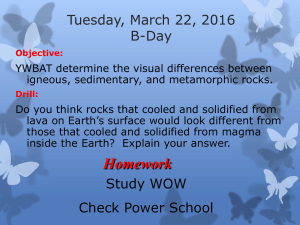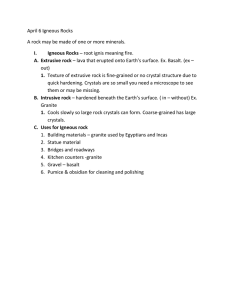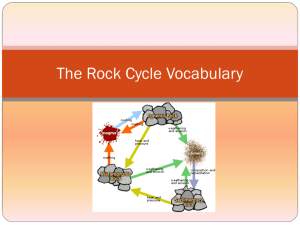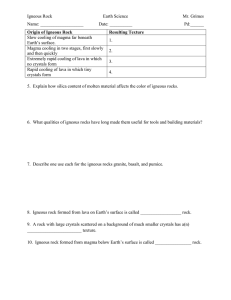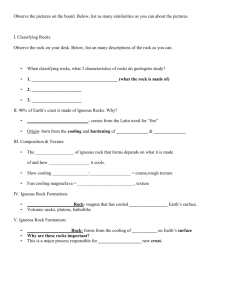Chapter 4 Section 2 Igneous Rock
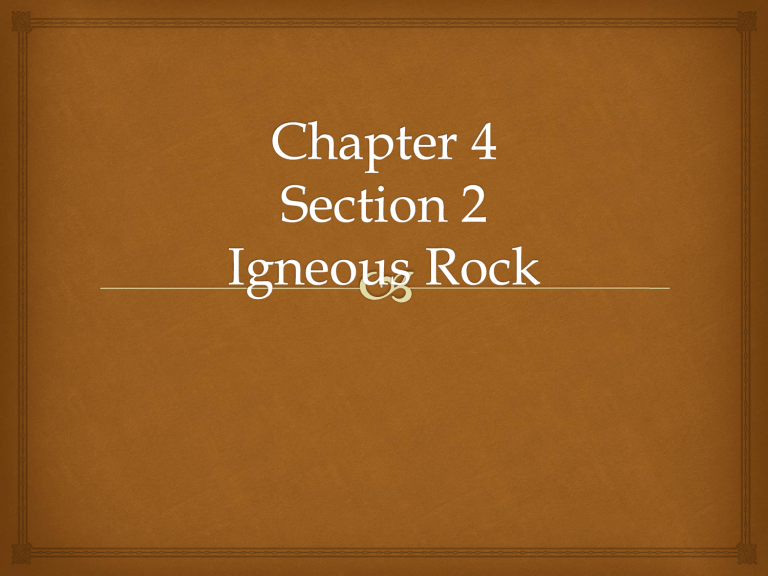
What is Igneous Rock?
Igneous rock forms when hot, liquid rock, or magma, cools and solidifies.
The type of igneous rock that forms depends on the composition of the magma and the amount of time it takes the magma to cool.
Origins of Igneous Rock
Igneous rock begins as magma.
There are three ways magma can form:
when rock is heated
when pressure is released
when rock changes composition.
Think about it!
Which of the following are ways magma is formed?
A. By compaction and cementation
B. By melting and cooling
C. By changes in composition
D. By weathering and erosion
Magma can Solidify
When magma cools enough, it solidifies to form igneous rock.
Magma solidifies in much the same way that water freezes.
Magma contain many different types of minerals, some minerals in the magma will freeze or become solid before other minerals do.
Composition and Texture
Let’s look at the rocks in Figure 2.
All of the rocks are igneous rocks even though they look different from one another.
These rocks differ from one another in what they are made of and how fast they cooled.
Composition Continued
The light-colored rocks are less dense than the darkcolored rocks are.
The light-colored rocks are rich in elements such as aluminum, potassium, silicon, and sodium.
These rocks are called felsic rocks. The dark-colored rocks, called mafic rocks, are rich in calcium, iron, and magnesium, and poor in silicon.
Figure 3 shows what happens to magma when it cools at different rates.
The longer it takes for the magma or lava to cool, the more time mineral crystals have to grow.
The more time the crystals have to grow, the larger the crystals are and the coarser the texture of the resulting igneous rock is
Think about it!
What kind of texture does igneous rock have when magma cools slowly?
A. Coarse-grained
B. Large-grained
C. Fine-grained
D. Medium-grained
Figure 3 should us what?
determines the texture of igneous rock.
The less time magma takes to cool, the less time crystals have to grow. Therefore, the rock that is formed will be fine grained.
Think about it!
What kind of texture does igneous rock have when magma cools rapidly?
A. Coarse-grained
B. Medium-grained
C. Fine-grained
D. Large-grained
Igneous Rock Formations
Above and Below the
Igneous rock formations are located above and below the surface of the Earth.
You may be familiar with igneous rock formations that were caused by lava cooling on the Earth’s surface, such as volcanoes.
But not all magma reaches the surface. Some magma cools and solidifies deep within the Earth’s crust
Intrusive Igneous Rock
When magma intrudes, or pushes, into surrounding rock below the Earth’s surface and cools, the rock that forms is called intrusive igneous rock.
Intrusive igneous rock usually has a coarsegrained texture because it is well insulated by surrounding rock and cools very slowly. The minerals that form are large, visible crystals.
Extrusive Igneous Rock
Igneous rock that forms from magma that erupts, or extrudes, onto the Earth’s surface is called extrusive igneous rock.
Extrusive rock is common around volcanoes. It cools quickly on the surface and contains very small crystals or no crystals.
Think about it!
What kind of rock is formed when magma intrudes into other rock?
A. Extrusive igneous rock
B. Sedimentary rock
C. Intrusive igneous rock
D. Organic sedimentary rock
Think about it!
What kind of rock is formed from lava that cools on the Earth’s surface?
A. Organic sedimentary rock
B. Sedimentary rock
C. Intrusive igneous rock
D. Extrusive igneous rock
Section Summary
Igneous rock forms when magma cools and hardens.
The texture of igneous rock is determined by the rate at which the rock cools.
Igneous rock that solidifies at Earth’s surface is extrusive. Igneous rock that solidifies within Earth’s surface is intrusive.
Shapes of common igneous intrusive bodies include batholiths, stocks, sills, and dikes.


